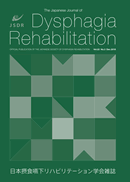Volume 9, Issue 1
The Japanese Journal of Dysphagia Rehabilitation
Displaying 1-14 of 14 articles from this issue
- |<
- <
- 1
- >
- >|
Historical Review
-
2005Volume 9Issue 1 Pages 3-11
Published: April 30, 2005
Released on J-STAGE: December 24, 2020
Download PDF (3899K) -
2005Volume 9Issue 1 Pages 12-16
Published: April 30, 2005
Released on J-STAGE: December 24, 2020
Download PDF (2516K) -
2005Volume 9Issue 1 Pages 17-22
Published: April 30, 2005
Released on J-STAGE: December 24, 2020
Download PDF (3168K) -
2005Volume 9Issue 1 Pages 23-26
Published: April 30, 2005
Released on J-STAGE: December 24, 2020
Download PDF (2115K) -
2005Volume 9Issue 1 Pages 27-35
Published: April 30, 2005
Released on J-STAGE: December 24, 2020
Download PDF (4382K) -
2005Volume 9Issue 1 Pages 36-39
Published: April 30, 2005
Released on J-STAGE: December 24, 2020
Download PDF (2153K) -
2005Volume 9Issue 1 Pages 40-45
Published: April 30, 2005
Released on J-STAGE: December 24, 2020
Download PDF (2779K) -
2005Volume 9Issue 1 Pages 46-50
Published: April 30, 2005
Released on J-STAGE: December 24, 2020
Download PDF (2167K)
Original Paper
-
2005Volume 9Issue 1 Pages 51-55
Published: April 30, 2005
Released on J-STAGE: December 24, 2020
Download PDF (1956K) -
2005Volume 9Issue 1 Pages 56-61
Published: April 30, 2005
Released on J-STAGE: December 24, 2020
Download PDF (2495K) -
2005Volume 9Issue 1 Pages 62-70
Published: April 30, 2005
Released on J-STAGE: December 24, 2020
Download PDF (3785K)
Research Report
-
2005Volume 9Issue 1 Pages 71-75
Published: April 30, 2005
Released on J-STAGE: December 24, 2020
Download PDF (2295K)
Clinical Report
-
2005Volume 9Issue 1 Pages 76-82
Published: April 30, 2005
Released on J-STAGE: December 24, 2020
Download PDF (3152K)
Clinical Hint
-
2005Volume 9Issue 1 Pages 83-85
Published: April 30, 2005
Released on J-STAGE: December 24, 2020
Download PDF (1229K)
- |<
- <
- 1
- >
- >|
